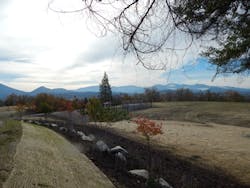Buried Tank Increases Capacity & Reliability
Located on the banks of the Rogue River in southern Oregon, the scenic City of Grants Pass offers recreational opportunities to the many tourists drawn to it each year. Named to honor General Ulysses S. Grant’s triumph at Vicksburg, Miss., the picturesque community is famous for its whitewater rafting and the nearby Oregon Caves National Monument.
Reservoir No. 3 Replacement Project
The City of Grants Pass had to evaluate whether to upgrade an aging buried water tank or replace it with a new one. The existing 3.5-million-gal rectangular, conventionally reinforced concrete tank, built in 1949, was in need of roof repairs and seismic upgrades that included new piping, columns and footings. The city analyzed not only the cost of building a new tank and upgrading the current tank, but also the benefits of each option.
After evaluating its system’s requirements, public safety concerns, community benefits and current versus future costs, the city chose to remove the existing tank and build a new, circular, American Water Works Assn. (AWWA) D110 Type I pre-stressed concrete water tank on the same site. While repairing an existing tank can be optimal in specific situations, a circular pre-stressed concrete tank was selected based on its durability and long-term service with minimal routine maintenance or out-of-service time. Ultimately, the decision to build a new 5-million-gal tank proved to be more economical and more than double the service life expectancy of the tank.
Project Team
The City of Grants Pass as managing agency hired a project team consisting of Murray, Smith & Associates as primary consultant; Peterson Structural Engineers Inc. as structural engineer; Ward-Henshaw Construction Inc. as tank contractor; and DN Tanks as tank pre-stressor. Through the collaborative efforts of the design and construction team, the project was successfully completed on time and under budget.
Project Benefits
The City of Grants Pass realized many benefits by choosing to build a new pre-stressed concrete tank rather than rehabilitating the existing tank. These included increases in savings, capacity and seismic reliability. Since the existing tank required considerable upgrades, it was not a cost-effective option. The decision to demolish it rather than rehabilitate it resulted in significantly lower project costs – not only in materials, but also in land acquisition. The city was able to take advantage of current low construction costs rather than deferring construction costs to significantly higher future prices. By utilizing the same site, the cost of future land acquisition was eliminated. Constructing the tank while other site improvement projects were performed simultaneously attained additional savings. This reflected efficient use of available land space while guaranteeing minimal disturbance to the surrounding community and keeping the facility in operation throughout tank construction.
New construction met the needs of the community in that ratepayers received a new tank with increased capacity without any additional financial burden placed upon them due to the renewal of an expiring bond at a low annual rate. The increased capacity provided greater emergency storage and high-demand water needs, as well as future storage needs and enhanced fire protection.
Another benefit of the project involved the increase in seismic reliability. The newly built circular, AWWA D110 Type I pre-stressed concrete tank was designed to meet current stringent seismic design requirements to ensure the reliability of the city’s critical water system infrastructure following a seismic event.
Environmental Considerations
Several measures were taken by the project team to mitigate both environmental factors and concerns of the community. During construction, sustainable practices included the stockpiling of excavated materials onsite for reuse, salvaging of appurtenances and repurposing of other materials reclaimed from the demolished existing tank.
The pre-stressed concrete tank was designed to be buried upon completion, thereby reducing the visual impact to the surrounding neighborhoods. The ability to bury the tank resulted in reduced maintenance costs and the ability to have a multi-use site. Storm water runoff was improved in an effort to decrease erosion, and a grassy area on top of the tank was added to complement nearby forested areas. Landscaping of native, drought-resistant plants, strategic placement of boulders and added fencing allowed the public to maintain use of the park area without any vehicular damage to the buried tank roof or aboveground appurtenances.
The provision of a safe work environment was paramount throughout all phases of project construction. Safety performance measures were implemented and compliance was strictly enforced to ensure that both workers and the public were safe at all times. The project had no reported lost-time accidents for construction or engineering personnel.
Results
Moving toward a more sustainable water supply, the City of Grants Pass chose a pre-stressed concrete tank because of its proven seismic performance, freedom from routine maintenance and ability to be fully buried. The new tank was designed to meet current stringent seismic design requirements to ensure the reliability of the city’s critical water system infrastructure after a seismic event.
Chris Young is regional manager for DN Tanks. Young can be reached at [email protected] or 503.893.5288.
